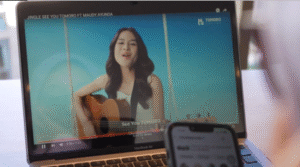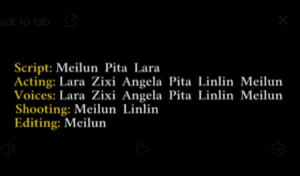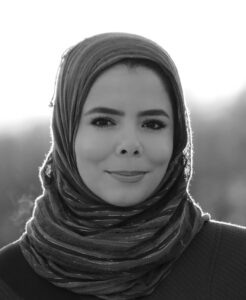In this post, Dr Maryam Almohammad and Master’s student, Lara Pacini, discuss their experience of group work through film-making – a creative, collaborative approach in the Intercultural Language Learner Identity course, part of the MSc in Language and Intercultural Communication at Moray House School of Education and Sport. This post is part of the Group Work series.
Maryam: As the Intercultural Language Learner Identity (ILLI) Course Organiser, I developed a creative, collaborative approach to researching and teaching intercultural communication using the arts. In groups, learners create short films in which they critique a social problem in their context, such as othering, racism, sexism, nationalism, xenophobia, and bullying, as part of their assessment. The process of preparing the film during workshops and outside opens a space for us and the learners to break the binaries between research and practice. Challenges include:
- The selection of a concept (e.g., othering, racism);
- Connecting it to a social phenomenon relevant to the lives of the group;
- Representing the phenomenon using symbolic systems (e.g., languages, colours, clothes, space) without falling into othering;
- Questions of ethics;
- Ownership of the collaborative work.
The project was facilitated through lectures on creativity, creative pedagogy and the arts, reading of case studies, and workshop discussions.
In one of my favourite films, a group of six students critiqued social media expectations of female roles in society, body image and the pressure to look like celebrities, repeating critically the sentences:
I am not Smart Enough – Brave Enough – Sexy Enough – Strong Enough – Thin Enough – Beautiful Enough – Outgoing Enough – not Smart and Hard Working enough – not Popular and Famous Enough – not Professional – not White enough.
This was followed by what appears as an interview in which each student spoke about their experiences and what they wanted to be. The learners end the film by wanting to be WISE ENOUGH in a world that prioritizes richness and commodifies knowledge and education. Next, one of the students – Lara Pacini – provides her reflections on the project and experiences of working as a group.
Lara: Rich course resources for group work collaboration
This course deeply engages learners in critical topics of culture, essentialism and imperialism, orientalism, colonialism, multiculturalism, diversity, creativity, and social media. This prepares us to think of the film group project and our individual course essay. The film-making group project turned out to be a beautiful collaboration with five other international students, which really pushed me to think beyond my own ‘bubble’. I loved interacting with my lovely colleagues and Dr Maryam. Hearing their perspectives made me feel curious and intellectually challenged.
I loved the freedom that Dr Maryam gave us to structure our own workshop discussions, building a horizontal and welcoming space for everyone. As I often feel pressured by strict tasks and ‘to-do’ lists, this approach helped me relax and truly listen to others while sharing my own thoughts. Consequently, our dialogues blossomed into deeper conversations, allowing us to develop a topic close to our hearts. We soon identified issues of gender, body image, and societal expectations as pressing, common issues in our lives. This was a truly touching moment because I felt our experiences resonated with each other despite our different backgrounds. I like to think that our stories were like seashells: similar, yet different, each unique and precious.
In our film, we explored the themes of societal control over female bodies, double standards around physical appearance and the demand to be popular and famous. Ultimately, the main message behind our film was our understanding how gender stereotyping shapes our lives, and what it feels like to think we may be ‘Not Girl Enough!’ according to social standards.
Our film: am I/are we ‘girl enough’?
The first theme we explore in the film is the societal control over female bodies. We realised how social pressure, often amplified by social media, impacted our mental health. We wanted to unpack these emotions by using the mirror and social media pictures to represent discomfort, pressure, and the often-lonely struggle of body dissatisfaction and dysmorphia. We found that open conversation and mutual support helped us feel seen, connected, and understood. This struggle is then transformed from private pain to collective empowerment, represented through a helping hand as a symbol of resistance against oppressive standards.
A second theme that we reflected on deals with double standards around appearance. Society expects us to look attractive and put together, but not too much, as we risk being accused of trying too hard. Yet clothes and makeup are forms of self-expression, and we believe we should be free to do what we want with our bodies without being objectified, fetishised, or sexualised. Our bodies belong to us, not to the gaze of others and not the voices of others. Where is the line? And more importantly, who draws it? This is why we decided to represent ourselves dressing for ourselves, empowered by our own choices over our body and how we choose to represent it.
Another theme concerns the pressure to always appear ‘outgoing’ or ‘brave’. A common and superficial narrative of feminism would want each of us to be ‘strong’, sociable, and always ready to fight for ourselves. This discourse is hurtful to those who, for many reasons, feel introverted and implies that there is something wrong with being quiet or introspective. We challenge the idea that females need to fight just to exist or prove their worth through ‘loudness’ and ‘confidence’. Activism is a right but also a privilege, and some of us would rather spend time with themselves sometimes, fighting their own internal battles, and that is valid, too.
We also addressed the burden of having to constantly prove we are ‘smart’ and ‘hard-working’. In academic and professional settings, women may be assumed to be less capable unless they go above and beyond. Family may also be part of that pressure. We may be asked to work twice as hard just because we are females and, yet, gain half the recognition. Or when we do get recognition, our work is often introduced, scrutinized and evaluated in a men-centric, White-focused lens. Once again, a friendly voice in the film serves to relieve anxiety and peer pressure, especially during our studies, making us feel connected and empowered.
In addition, we questioned the demand to be ‘popular and famous’, to envy those who are, and to crave constant external validation. We found these ideas problematic as they implied that our values depend on how others perceive us. Social media amplifies this pressure by selling us unattainable standards promoted by famous singers or models. We believe that social media should be seen for the highly commodified, market-driven tool that it is, finding ourselves in our individuality and actions.

Finally, we examined how gender stereotypes affect our life choices. A girl should choose ‘feminine’ jobs. When we do succeed into ‘male fields’, we are often questioned or celebrated just because we made it ‘as a female’, and not because our accomplishments. However, we refuse to accept that hobbies and passions are gendered. We feel that we need to encourage and support each other to pursue whatever drives us, regardless of societal expectations.
Recommendations for future freedom in group work
Group work is not always easy and simple. Furthermore, for most of us, this course represented our first endeavour in film-making.
- What makes group work successful and what lessons did we take from the experience?
In this course, workshops were not just sessions to get things done, but forums where we were allowed to slowly piece our ideas together using the readings, empirical examples, flip charts, and drawing. When given more autonomy and responsibility, we began to share our understanding by connecting complex and abstract theories to our everyday lives. We were encouraged to discard the idea of simply ‘completing a task’ and instead think more deeply about what we were creating and why. This was beneficial for promoting a hands-on approach to topics that can feel abstract, while also helping us bond with classmates in a meaningful way. Dr Maryam also emphasised the importance of producing something “authentic” with a meaningful message rather than “perfect”, helping us manage our expectations and stress and comments by our course organiser was crucial to creating a creative environment. The project was feasible within our weekly schedule, leaving time for script-writing, shooting, and editing. This contributed to a relaxed and enjoyable experience, and looking back at our video, we really think: “That’s us!”.
- What resources do you need for group work?
Employing different representation including embodied performance, phones, bodies, hands, and touching faces, social media posts, staring and speaking at mirrors and the camera as a mirror in dark room, the black and white, and sometimes natural colors depending on the symbolic power of the topic. This allows us to constructed how social media voices attempt to govern our emotions and how the public perceives us using mother tongue (Italian, Indonesian, and Chinese, English). Engaging with group work in a multilingual setting, where everyone is using a second (or even third, or fourth!) language, can be challenging. Nonetheless, this is not an inherent limitation, with the film multilingual project, it becomes a strength. I often found myself thinking, “How do I get myself understood?”, and this process of looking for the right words helped me polish my ideas and express myself in unexpected ways.
So, my final thoughts about group work to fellow students:
- speak, in any language, medium or tool you have;
- engage with others;
- embrace messiness and confusion.
Credit list for film
Thanks to my amazing course organiser, Dr Maryam, and my lovely group mates: Pita, Meilun, Zixi, Angela, and Linlin.

Lara Pacini

Lara is a Master’s student in Language Education interested in the sociological dimensions of learning and teaching. Her dissertation explored the experiences of Italian university students returning from study abroad, highlighting the role of international mobility in their identity and language learning trajectories. Building on this work, she is also interested in community and adult education for migrants, and the use of participatory ethnography to explore educational practices in diverse contexts.
Maryam Almohammad

Dr. Maryam Almohammad is a sociologist of culture working at the University of Edinburgh in the MSc in Language and Intercultural Communication. Her interdisciplinary research and teaching focus on critical intercultural communication, multiculturalism policies, social justice in education and society, the ethics and philosophy of communication, and qualitative, ethnographic, and artistic research methods.


